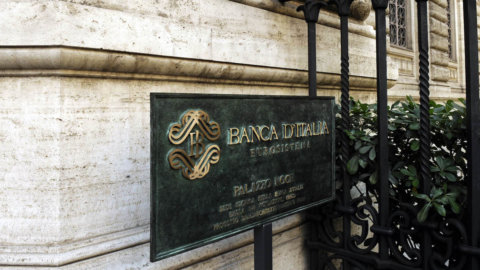Bank of Italy cut our GDP estimates and report downside risks to economic growth, while the debt reduction “is only marginal”. This is the gloomy picture that emerges from the latest economic bulletin from Bank of Italy which revised downwards the GDP estimates released last July to +0,7% this year and +0,8% in 2024, while confirming growth by 1% in 2025. “Growth would be affected by the tightening of financing conditions and the weakness of international trade; it would instead benefit from the effects of the Pnrr measures and the gradual recovery of families' purchasing power", we read in Bulletin. These numbers compare to a Nadef, the accounting framework in which the Budget will be depicted, which instead sees the trend GDP rise by 0,8% in 2023, 1% in 2024 and 1,3% in 2025. While as regards theinflation, it is estimated at drop to 2,4% in 2024 (from 6,1 in 2023) and to 1,9 in 2025. Core inflation would fall to 2,3% in 2024 (from 4,6 in 2023) and to 1,9. 2025 in XNUMX, in line with the progressive fading of the effects of past and exceptional energy price increases and with the slowdown in domestic demand. Strong concerns concern the debt, the reduction "is only marginal" and with risks "tendently upward".
Looking ahead, we assume the worst. With the worsening of geopolitical tensions in particular related to the conflict in Ukraine and with the very serious developments of terrorist attacks in the Middle East; the worsening of the Chinese economy and the eldest rigidity of credit supply conditions in Italy, as well as in the euro area as a whole. All elements that constitute downside risks for economic growth. The risks for inflation, however, are balanced: the upward risks are connected with a further increase in the price of raw materials and with a slower transmission speed of the recent decline in production costs (from the exceptionally high levels of 2022), while a more marked deterioration and persistent aggregate demand constitutes the main downside risk.
The crisis in the Chinese real estate sector and the possible repercussions on the global economy
After the crack of Evergrande another blow to the Chinese economy comes from Country Garden: The real estate giant may fail to repay its debts abroad. Last September, the largest Chinese real estate company by turnover narrowly avoided default, but now the potential mine seems ready to explode. But what are the possible economic and market impacts on a global level?
Alarm bells continue to ring, but the repercussions on the international financial markets would be modest: on the one hand the foreign exposure of companies in the real estate sector is limited, on the other the controls on capital movements are still relevant. While the economic impact would be stronger: available estimates show that overall a 15% decrease in the value of homes in China would cause a slowdown in the country's GDP by 1%. This in turn would lead to a negative impact on global growth and trade. The reduction in output growth would be up to 2 tenths of a point in the United States and between 1 and 5 tenths in the euro area. In this scenario, the prices of raw materials, especially those of which China is a significant importer at a global level, would reduce to a non-negligible extent.
Growth is slowing and inflation is reducing in the euro area
According to estimates by Via Nazionale il GDP stagnation in the euro area, underway since the end of 2022, also continued in the summer months. The more rigid financing conditions - due to the monetary tightening - and the effects of high inflation on the purchasing power of families had an impact. Activity remains sluggish in manufacturing and weakens in services; signs of cooling have emerged in the labor market. In September, consumer and core inflation fell to 4,3 and 4,5 percent, respectively. In the projections of the ECB experts, the dynamics of consumer prices will decrease markedly in 2024 (to 3,2%) and in 2025 (to 2,1%). This downward path is supported by the reduction in inflation of the most persistent items in the basket of goods and services.
The ECB's monetary tightening
In July and September the ECB increased rates again. And it also reiterated that it intends to flexibly reinvest, at least until the end of 2024, the capital repaid on maturing securities under the Pandemic Emergency Securities Purchase Program (PEPP). In the euro area, the cost of financing for businesses and families has risen further, reflecting the rise in official rates; the returns on ten-year public bonds are increased, as well as the differentials of the Italian ones with the corresponding German securities.
Italy, growth remained weak in the summer
According to Bank of Italy's assessments, after the decrease in the second quarter the recovery phase continued weakness of economic activity in Italy, extended to both manufacturing and services. The indicators confirm the weakness of domestic demand, which reflects the tightening of credit access conditions, the erosion of family incomes due to inflation and the loss of vigor in the labor market. Exports are affected by both the lack of liveliness in global demand and economic activity in the euro area.
In the two-month period July-August the labor market showed signs of a slowdown: employment and the participation rate remained essentially stable.
Bank loans down, cost of credit increases
Between May and August the credit to families and businesses it is again decreased. The demand for financing is held back both by the increase in the cost of loans and by the lower liquidity needs for investments. Bank surveys also highlight that the greater risk perceived by intermediaries and the lower willingness to tolerate it continue to contribute to a tightening of loan granting policies, thus weakening their dynamics.
Debt reduction "is only marginal", with upside risks
“According to the new public finance objectives – updated by the Government at the end of September – in 2023 thenet borrowing and debt to GDP ratio they would continue to decrease and would stand at 5,3 and 140,2% respectively. An expansion of the deficit compared to the current legislative framework of approximately 2024 percentage points of GDP is scheduled for 0,7. Net debt would gradually decline over the next few years, up to 2,9% of GDP in 2026. The impact of debt on product over the next three years would mark only a marginal reduction, with risks tending towards the upside", concludes Bank of Italy.





